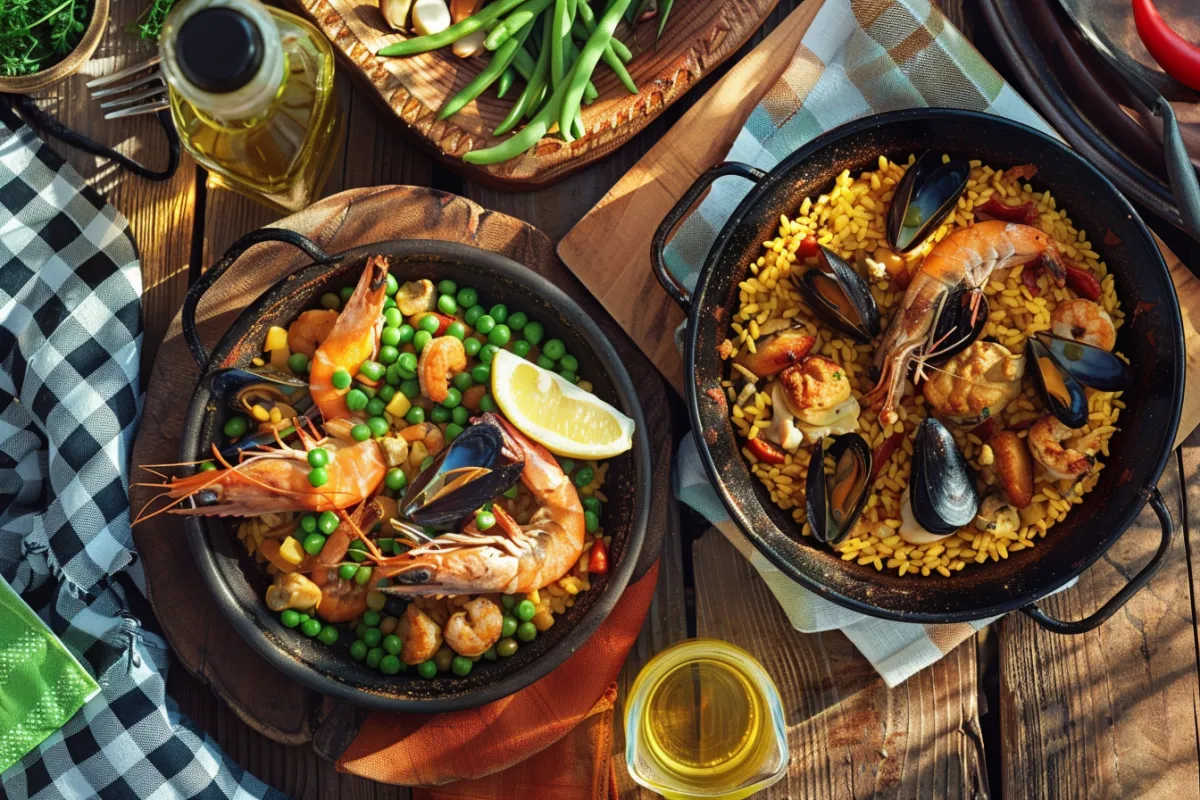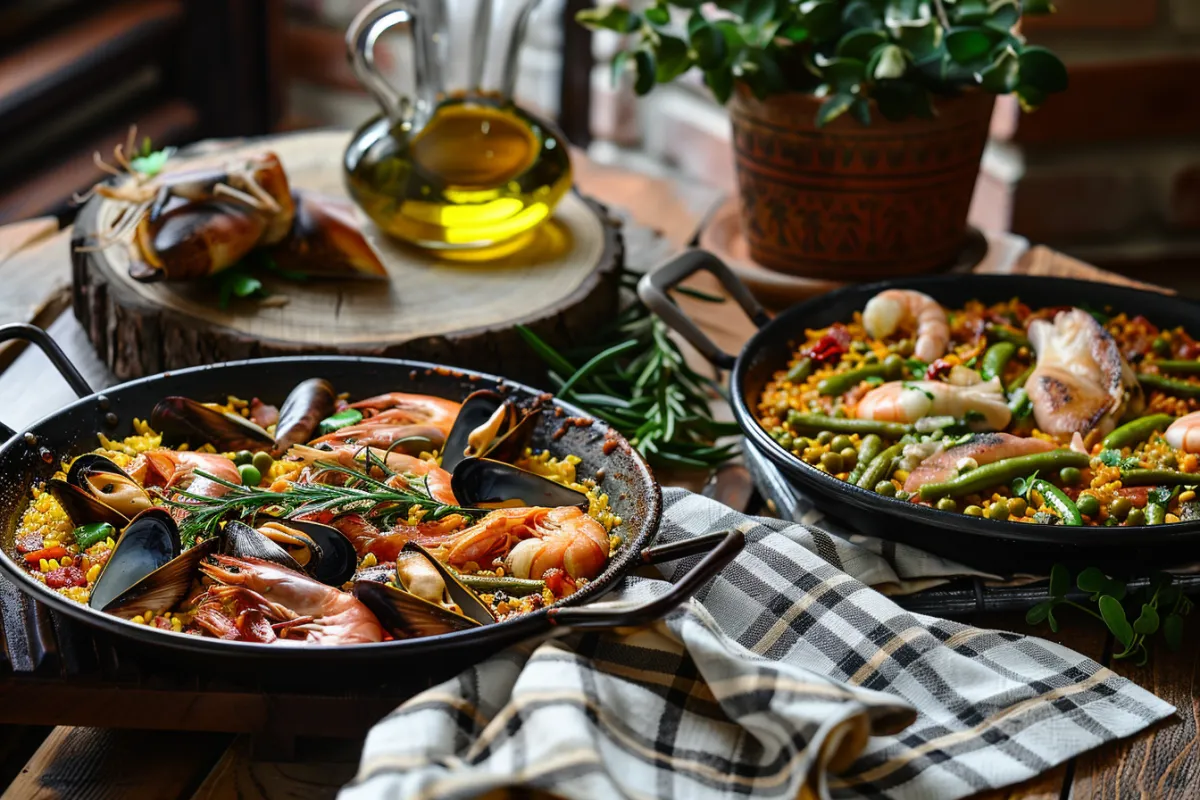When you think of Spanish cuisine, one of the first dishes that likely comes to mind is paella. This vibrant, flavorful rice dish comes in many forms, but two of the most popular are paella de mariscos (seafood paella) and paella Valenciana (the traditional Valencian version). While both dishes share a common base, their ingredients, preparation methods, and cultural significance differ. In this article, we will explore the key differences between these two beloved types of paella, breaking everything down in a simple and engaging way.
The Origins of Paella
Before diving into the differences between paella de mariscos and paella Valenciana, it’s important to understand the origins of paella itself.
The Origin of Paella in Valencia
Paella originated in the region of Valencia, Spain, during the 18th century. Farmers would prepare this hearty dish using rice, which was abundant in the region thanks to the Moors who introduced rice cultivation to Spain. The original version, known today as paella Valenciana, was made with ingredients that were readily available—typically rabbit, chicken, and local vegetables like green beans and garrofón (a type of large lima bean). This version of paella became a symbol of Valencian culture and remains a beloved dish in the region.
The Evolution of Seafood Paella (Paella de Mariscos)
As paella spread to coastal regions of Spain, particularly along the Mediterranean, seafood naturally became a key ingredient. This led to the creation of paella de mariscos, which features a variety of seafood instead of the meat and vegetables found in paella Valenciana. This version of paella highlights Spain’s rich maritime tradition and the Mediterranean diet.
Ingredients: Paella de Mariscos vs. Paella Valenciana
One of the primary differences between paella de mariscos and paella Valenciana is the choice of ingredients. Let’s take a closer look at what goes into each dish.

Key Ingredients in Paella Valenciana
- Meats: The hallmark of paella Valenciana is its use of land-based proteins, particularly rabbit and chicken. Some versions also include snails.
- Vegetables: Traditional paella Valenciana includes green beans and garrofón (lima beans). In some regions, artichokes are also added.
- Spices: Saffron and paprika are essential to paella Valenciana, giving the dish its distinctive flavor and color.
- Stock: A rich meat-based stock is used to cook the rice, adding depth to the flavor.
Key Ingredients in Paella de Mariscos
- Seafood: Paella de mariscos is all about seafood. Common ingredients include prawns, mussels, clams, squid, and sometimes langoustines.
- Rice and Stock: The rice is cooked in seafood stock, which enhances the briny flavors of the dish.
- Saffron: Like paella Valenciana, paella de mariscos uses saffron, but the overall flavor is lighter and more focused on the fresh seafood.
Ingredient Variations Between the Two Dishes
- Rice: Both dishes typically use short-grain rice varieties like Bomba or Calasparra, which are excellent at absorbing liquid.
- Vegetables and Spices: While paella Valenciana leans heavily on vegetables and paprika for flavor, paella de mariscos keeps the focus on the seafood and the saffron-infused rice.
Cooking Methods and Techniques
Though the base ingredients are similar, the cooking methods for paella de mariscos and paella Valenciana differ in important ways.
Cooking Process for Paella Valenciana
- Prepare the Sofrito: A mixture of garlic, tomatoes, and paprika is cooked in olive oil to form the base.
- Sear the Meats: Rabbit and chicken are browned in the pan before adding the sofrito.
- Add the Vegetables: Once the meats are seared, green beans and garrofón are added to the pan.
- Cook the Rice: The rice is added to the mixture, followed by a meat-based stock. Saffron is stirred in for flavor and color.
- Achieve the Socarrat: As the rice cooks, the heat is increased toward the end to create the socarrat, a crispy layer of rice at the bottom of the pan.
Cooking Process for Paella de Mariscos
- Prepare the Seafood: Clean and prep the seafood, making sure the clams and mussels are scrubbed and the prawns are deveined.
- Make the Sofrito: Similar to paella Valenciana, paella de mariscos starts with a sofrito of garlic, tomatoes, and olive oil.
- Cook the Rice: Seafood stock is used instead of meat stock, and the rice is cooked until it absorbs all the rich flavors.
- Layer the Seafood: The seafood is added toward the end, allowing it to steam atop the rice without overcooking.
- Finish with the Socarrat: Like paella Valenciana, paella de mariscos should have a crispy bottom layer of rice.
Tools and Equipment
Both dishes are traditionally cooked in a wide, shallow paella pan over an open flame. This allows the rice to cook evenly and helps create the perfect socarrat.
Taste and Texture Differences
The most noticeable differences between paella de mariscos and paella Valenciana come from their distinct flavor profiles and textures.
The Flavor Profile of Paella Valenciana
- Earthy and Savory: The meat and beans give paella Valenciana a rich, earthy flavor. The saffron and paprika add warmth, while the crispy socarrat provides a satisfying crunch.
- Complex: The combination of meat, vegetables, and spices makes paella Valenciana a hearty and complex dish.
The Flavor Profile of Paella de Mariscos
- Light and Briny: Paella de mariscos is lighter in flavor, with the seafood imparting a briny, oceanic taste to the rice.
- Fresh and Simple: The focus is on the natural flavors of the seafood, making it less complex but equally delicious.
Texture Comparisons
- Paella Valenciana: The inclusion of meat and beans gives this dish a denser texture. The socarrat is typically more pronounced in paella Valenciana due to the meat and stock.
- Paella de Mariscos: The seafood in paella de mariscos creates a lighter texture. The rice is often more moist due to the seafood stock, and the seafood itself should be tender and juicy.
Cultural Significance and Regional Preferences
Both types of paella are deeply embedded in Spanish culture, but they are celebrated in different ways depending on the region.
Paella Valenciana’s Role in Valencian Culture
In Valencia, paella Valenciana is more than just food—it’s a point of regional pride. The dish is often prepared at large family gatherings and festivals, and there are even competitions to determine who makes the best paella Valenciana. For Valencians, this dish is a reflection of their history and traditions.
Paella de Mariscos in Coastal Spain
Paella de mariscos is popular in Spain’s coastal regions, particularly in places like Andalusia, Catalonia, and the Canary Islands. It reflects the Mediterranean diet, which emphasizes fresh seafood and simple, wholesome ingredients. While paella Valenciana is rooted in land-based farming traditions, paella de mariscos is a celebration of Spain’s maritime culture.
Nutritional Differences Between Paella de Mariscos and Paella Valenciana
From a nutritional standpoint, these two dishes also have some distinct differences.
Paella Valenciana’s Nutritional Profile
- High in Protein: Thanks to the rabbit and chicken, paella Valenciana is a good source of lean protein.
- Rich in Fiber: The beans and vegetables provide a healthy dose of fiber.
- Moderate in Fat: The use of olive oil and meat adds some fat, but it’s mostly heart-healthy fat from the olive oil.
Paella de Mariscos’ Nutritional Profile
- Omega-3 Fatty Acids: The seafood in paella de mariscos is rich in omega-3s, which are beneficial for heart and brain health.
- Lower in Calories: Since paella de mariscos uses seafood instead of meat, it tends to be lower in calories and fat.
- Packed with Vitamins and Minerals: Seafood is an excellent source of vitamins and minerals like vitamin B12, selenium, and iodine.
Popular Variations and Modern Takes on Both Paellas
While the traditional versions of paella de mariscos and paella Valenciana are cherished, modern chefs have started putting their own spin on these classic dishes.
Regional Variations of Paella Valenciana
- Artichokes and Red Peppers: In some regions, additional vegetables like artichokes or red peppers are added to paella Valenciana for extra flavor.
Modern Interpretations of Paella de Mariscos
- Luxury Ingredients: Some chefs elevate paella de mariscos by adding luxury ingredients like lobster or scallops.
- Vegan and Vegetarian Paellas: These versions mimic the structure of traditional paella, using plant-based alternatives for the seafood or meat.
Frequently Asked Questions
What is the meaning of paella de marisco?
Paella de marisco simply means “seafood paella.” It’s a version of paella that highlights fresh seafood like prawns, mussels, and clams, cooked with saffron-infused rice.
What are the three types of paella?
The three main types of paella are:
- Paella Valenciana: A traditional version made with rabbit, chicken, and vegetables.
- Paella de mariscos: A seafood version with ingredients like prawns, mussels, and squid.
- Paella mixta: A combination of both meat and seafood.
What is the difference between paella and mariscada?
While paella is a rice-based dish, mariscada is a seafood platter that typically includes a variety of shellfish but no rice. Both celebrate fresh seafood but are prepared and served differently.
Conclusion
In summary, the difference between paella de mariscos and paella Valenciana lies in their ingredients, flavors, and cultural roots. While paella Valenciana reflects the land-based traditions of Valencia, paella de mariscos celebrates Spain’s coastal regions and the Mediterranean diet. Both dishes offer unique and delicious experiences, making them essential to any exploration of Spanish cuisine. Whether you prefer the rich, earthy flavors of paella Valenciana or the light, briny taste of paella de mariscos, there’s no denying the joy of sharing a pan of paella with friends and family!

